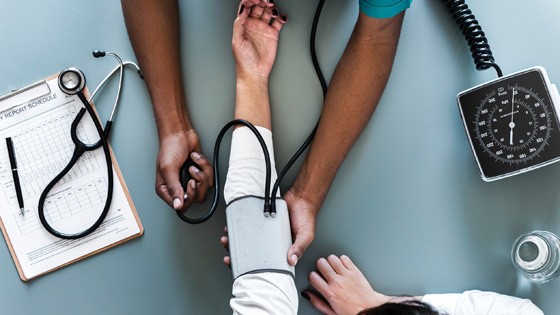Preeclampsia is a severe condition that occurs only in pregnancy and requires medical attention. Knowing the first signs of preeclampsia might help you detect it in its early stages if it happens to you.

Warning Signs of Preeclampsia
Preeclampsia can occur with a sudden increase in high blood pressure or as a silent disease, meaning that it doesn’t produce any noticeable symptoms or signs. However, that doesn’t imply it is not dangerous and may also lead to severe complications!
Knowing the first warning signs of preeclampsia may help you detect it sooner, but that doesn’t mean you can miss your regular prenatal checkups! Your health care provider will measure your blood pressure and conduct additional tests if needed.
Preeclampsia can occur as a silent disease, or it can mimic usual pregnancy symptoms. That’s why are your prenatal visits so important. If preeclampsia starts in one of such forms, a pregnant woman doesn’t notice any symptoms. In such a case, only regular prenatal appointments by screening blood pressure and urine can detect it soon enough.
A pregnant woman with preeclampsia is closely monitored and treated if needed. Most pregnant women with properly treated preeclampsia give birth completely normal, with no complications for both mother and baby.
RELATED: Preeclampsia In Pregnancy
What are the first signs of Preeclampsia?
As said before, some women with mild preeclampsia might not have any noticeable symptoms at all. However, most pregnant women with preeclampsia develop symptoms, such as high blood pressure, sudden edema, headache, etc.
Among them, a rise in blood pressure is certainly one of the firsts and most known warning signs, which indicates that a pregnant woman developed preeclampsia.
High blood pressure is a typical sign of preeclampsia. If you have blood pressure 140/90 or higher, consult with your health care provider!
However, having high blood pressure alone does not necessarily mean that you are developing preeclampsia, so further actions are needed. A health care provider will conduct additional urine and blood tests, which will confirm or rule out the condition.
Proteins in the urine are actually one of the first warning signs of preeclampsia, but they can be detected only by urinalysis on prenatal visits. Preeclampsia affects the kidneys, causing proteins to spill into the pregnant woman’s urine. Given the presence of proteins in the urine, the doctor may suspect preeclampsia already in its early stages.
As you cannot detect proteins at home, it is worth remembering the symptoms, which you have to pay attention to during pregnancy, as they can be a sign of preeclampsia.
First signs of preeclampsia may include:
- High blood pressure (hypertension) is one of the first signs you’re developing preeclampsia. If your blood pressure is 140/90 or higher, talk to your doctor. He will determine if it is preeclampsia or some other condition, prescribe medication if necessary, and suggest regular blood pressure monitoring at home.
- Severe headaches, that don’t go away with over-the-counter pain medication.
- Changes in your vision such as blinking, flashing, or sparking in front of the eyes, blurry vision, or light sensitivity
- Pain in the spleen and upper abdomen, under the right ribs
- Sudden swelling in legs, feet, face, and hands, leading to a rapid weight gain (more than 4 pounds in a week). Extra fluid and pressure of the uterus often cause edema, and it is common in pregnancy. However, if the swelling occurs suddenly or it is accompanied by high blood pressure, call your doctor immediately.
- Nausea or vomiting: Most pregnant women experience morning sickness, which usually ends after the first trimester. Some women also experience nausea throughout the whole pregnancy. But if nausea goes away and then suddenly reappears in the last trimester, it may be a sign of preeclampsia.
- Shortness of breath
- A pregnant woman’s reflexes become unusually active due to increased blood pressure.
Note! The signs of preeclampsia listed above do not necessarily mean you have developed the condition. Any of them can be either a sign of preeclampsia, or a common pregnancy problem, or a symptom of other diseases. So, if any occurs, consult your doctor if further actions are needed.
Severe signs of Preeclampsia
Pregnant women with preeclampsia may also experience one or more following symptoms. These are more severe signs that usually appear later and require immediate medical attention.
- Heavy breath, which is caused by fluid accumulation in the lungs.
- Impair kidney function, which shows in the decreased urine output or other signs of kidney problems.
- Noticeable tiny purple, red, or brown spots on the skin (petechiae). That is small spotted bleeding from capillaries, which indicates a decreased platelet count in the blood, leading to a greater tendency to bleed.
- Preeclampsia‐induced liver disease
- Temporary vision loss
- Confusion
RELATED: What Causes Preeclampsia During Pregnancy?
Take away
A pregnant woman may experience various symptoms that may indicate she is developing preeclampsia. But high blood pressure is one of the first and most common signs of the condition.
Although high blood pressure does not necessarily mean a pregnant woman has preeclampsia, it is not normal and should be a warning sign to call the doctor.
If you notice any of the signs listed above, or if you are not sure about your condition, call your health care provider.
The best preventive against preeclampsia is regular prenatal care.
RELATED:
